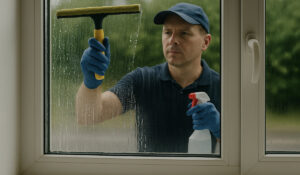Building maintenance is essential to ensure safety, aesthetics, and durability. Over time, environmental pollution, acid rain, and microorganism growth can deteriorate facades and structures. Traditionally, cleaning was done using scaffolding or lift platforms, but these methods can be costly and inefficient.
This is where high-pressure cleaning in rope access work comes in—a modern method that allows specialized technicians to clean facades and other high surfaces safely, quickly, and effectively. Using certified ropes and harnesses, professionals can access hard-to-reach areas without the need for temporary structures, reducing costs and improving efficiency.
Basic Principles of High-Pressure Cleaning in Rope Access Work
High-pressure cleaning is a method that uses pressurized water to remove dirt, mold, fungi, and other residues from surfaces. This process is carried out with equipment designed to regulate water pressure, ensuring effective cleaning without damaging materials.
In rope access work, this technique is combined with climbing and descent systems, allowing workers to move safely along the building’s facade. This system is especially useful for cleaning hard-to-reach surfaces such as windows, metal structures, and glass panels.
Benefits of High-Pressure Cleaning for Building Conservation
Opting for high-pressure cleaning in rope access work offers several key advantages:

Greater efficiency: Cleans surfaces quickly and effectively.
Cost savings: Reduces the need for scaffolding and heavy equipment.
Safety: Certified technicians work with specialized equipment to minimize risks.
Eco-friendly approach: Often, only water is used, avoiding harsh chemicals.
Longer building lifespan: Prevents contaminants from accelerating structural deterioration.
Common Applications in Facade and Structure Maintenance
High-pressure cleaning at heights is used in various applications, including:
Facade cleaning for glass, concrete, brick, and metal surfaces.
Mold and fungus removal on surfaces exposed to constant moisture.
Cleaning metal and concrete structures such as bridges, tunnels, and industrial buildings.
Roof and gutter maintenance to prevent debris buildup and water leaks.
Cleaning monuments and urban sculptures without damaging original materials.
Safety and Regulations in Rope Access Work with High-Pressure Cleaning
Safety is a fundamental aspect of working at heights. Professionals must have certifications proving their ability to perform these tasks safely. Additionally, specific regulations must be followed, such as:
Mandatory use of personal protective equipment (PPE): harnesses, helmets, gloves, and safety goggles.
Pre-work area inspections: to identify potential risks.
Ongoing training: Technicians must receive continuous safety and cleaning technique training.
Compliance with local and international regulations: such as height safety standards.
Differences Between High-Pressure Cleaning in Rope Access Work and Other Height Cleaning Methods
Compared to other techniques, high-pressure cleaning in rope access work stands out for:
Speed: Reduces setup and takedown times compared to scaffolding.
Minimal impact on building operations: Does not interfere with occupants’ daily activities.
Better accessibility: Reaches areas that other methods cannot.
Lower costs: Eliminates the need for temporary structures, optimizing maintenance budgets.
Common Problems
Although high-pressure cleaning in rope access work is highly effective, some issues can arise if not performed correctly:
Improper pressure settings: Can damage delicate materials if not adjusted properly.
Lack of equipment maintenance: Can cause cleaning failures and increase safety risks.
Incorrect choice of cleaning products: Some chemicals may cause corrosion or stains.
When Should You Consult a Professional?
It is advisable to seek a high-pressure cleaning specialist in the following cases:
When accumulated dirt is difficult to remove with conventional methods.
If the facade has mold, fungi, or difficult stains.
When there is a risk of structural deterioration due to residue buildup.
If specialized cleaning is required for monuments or historic structures.
High-pressure cleaning in rope access work has become an essential solution for maintaining high-rise buildings. Its efficiency, cost-effectiveness, and low environmental impact make it an ideal choice for keeping facades and structures in top condition.
At Sapphire Window Cleaning, we take pride in being your trusted provider specializing in window cleaning and maintenance for medium and high-rise buildings.
Our commitment to excellence, combined with innovative techniques and state-of-the-art equipment, ensures that your property receives the care and attention it deserves, maintaining its impeccable appearance and extending the lifespan of its structures.
Are you ready to enhance the look and durability of your property? We invite you to learn more about our services by visiting our website or contacting us through this link.
Frequently Asked Questions (FAQs)
What is high-pressure cleaning in rope access work?
It is a technique that uses high-pressure water to clean surfaces at height without scaffolding.What are the benefits of this cleaning method?
Greater efficiency, lower costs, increased safety, and reduced environmental impact.What types of buildings can benefit from this cleaning method?
Skyscrapers, offices, factories, hotels, and historic buildings.Is this procedure safe?
Yes, as long as certified technicians using proper equipment perform it.How often should high-pressure cleaning be done?
It depends on pollution levels and surface type, but generally once or twice a year.What types of dirt can be removed?
Dust, mold, fungi, graffiti, pollution residues, and water stains.Can glass surfaces be cleaned using this technique?
Yes, but pressure settings must be adjusted to prevent damage.How much does high-pressure cleaning in rope access work cost?
It varies based on the building’s size and the type of surface to be cleaned.How can I choose a reliable cleaning company?
Look for certifications, experience, and customer reviews.Is a special permit required for this type of cleaning?
In some cases, depending on local regulations.Can this method remove graffiti from facades?
Yes, high-pressure cleaning effectively removes graffiti from various surfaces.Does this method use chemicals?
It primarily uses water, but some cases require mild cleaning agents.What should I do before scheduling high-pressure cleaning?
Consult a professional to assess the building’s needs.Does high-pressure cleaning damage old buildings?
If done correctly, it does not cause damage but helps preserve the structure.Can this method be used on all facade materials?
Yes, but pressure must be adjusted depending on the material.




